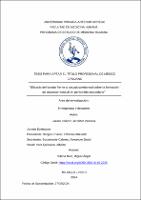Mostrar el registro sencillo del ítem
Eficacia del lavado frente al secado peritoneal sobre la formación de absceso residual en peritonitis secundaria
| dc.contributor.advisor | Villena Ruiz, Miguel Ángel | |
| dc.contributor.author | Lázaro Chávez, Jenniffer Vanessa | |
| dc.creator | Lázaro Chávez, Jenniffer Vanessa | |
| dc.date.accessioned | 2024-03-15T22:08:57Z | |
| dc.date.available | 2024-03-15T22:08:57Z | |
| dc.date.issued | 2024 | |
| dc.identifier.uri | https://hdl.handle.net/20.500.12759/24472 | |
| dc.description.abstract | Objetivo: Determinar la eficacia del lavado frente al secado peritoneal sobre la formación de absceso residual por peritonitis secundaria en pacientes del Hospital José Soto Cadenillas durante el periodo septiembre del 2016 y septiembre del 2022. Material y Método: Este estudio fue de tipo observacional, analítico de cohorte retrospectiva. Se incluyó a 89 pacientes, los cuales fueron divididos según el factor de exposición, siendo 52 pacientes los que fueron sometidos a lavado peritoneal (grupo expuesto) y 37 los que se sometieron a secado peritoneal (no expuesto). Se evaluó la incidencia del absceso residual intraabdominal en el grupo de expuestos y no expuestos. Adicionalmente, se determinó la asociación del absceso residual con las variables intervinientes. Se utilizó la prueba Z de comparación de proporciones y la prueba de Chi-cuadrado de Pearson. La fuerza de asociación se determinó mediante el riesgo relativo (RR). Resultados: La edad promedio de los pacientes con peritonitis secundaria fue de 44 años, siendo el 47.2% del sexo femenino y el 52.8% del sexo masculino, la mediana de tiempo operatorio 45min y la mediana de estancia hospitalaria 8 días. Según la prueba de Risk Ratio (RR), por análisis multivariado determinó que los pacientes que fueron sometidos a lavado peritoneal muestran 1,05 veces más riesgo de evidenciar absceso residual frente a aquellos pacientes sometidos a secado peritoneal, siendo esta asociación no significativa (RRa = 1.05; IC 95%: 0.16 – 2.00; p=0.98); no obstante, un tiempo operatorio mayor o igual a 45 minutos manifestó ser un factor de riesgo significativo para absceso residual en pacientes con peritonitis secundaria (RRa = 3.95; IC 95%: 1.16 – 13.46; p = 0.03). Conclusión: El lavado peritoneal no es más eficaz que el secado peritoneal sobre la formación de absceso residual en pacientes con peritonitis secundaria | es_PE |
| dc.description.abstract | Objective: Determine the effectiveness of lavage versus peritoneal drying on the formation of residual abscess due to secondary peritonitis in patients at the José Soto Cadenillas Hospital during the period September 2016 and September 2022. Material and Methods: The present study was an observational, retrospective cohort analytical study. 89 patients were included, who were divided according to the exposure factor, with 52 patients undergoing peritoneal lavage (exposed group) and 37 patients undergoing peritoneal drying (non-exposed). The incidence of residual intra-abdominal abscess was evaluated in the exposed and non-exposed group. Additionally, the association of the residual abscess with the intervening variables was determined. The Z test for comparison of proportions and Pearson's Chi square test were used. The strength of association was determined using the relative risk (RR). Results: The average age of patients with secondary peritonitis was 44 years, 47.2% were female and 52.8% were male, the median operative time was 45min and the median hospital stay was 8 days. According to the Risk Ratio (RR) test, multivariate analysis determined that patients who underwent peritoneal lavage showed a 1.05 times greater risk of developing residual abscess compared to those patients who underwent peritoneal drying, this association being non-significant ( RRa = 1.05; 95% CI = 0.16 – 2.00; p = 0.98); However, an operative time greater than or equal to 45 minutes appeared to be a significant risk factor for residual abscess in patients with secondary peritonitis (aRR = 3.95; 95% CI = 1.16 – 13.46; p = 0.03). Conclusion: Peritoneal lavage is not more effective than peritoneal drying on residual abscess formation in patients with secondary peritonitis | es_PE |
| dc.description.uri | Tesis | es_PE |
| dc.format | application/pdf | |
| dc.language.iso | spa | es_PE |
| dc.publisher | Universidad Privada Antenor Orrego | es_PE |
| dc.relation.ispartofseries | T_MED_3765 | |
| dc.rights | info:eu-repo/semantics/openAccess | es_PE |
| dc.rights.uri | https://creativecommons.org/licenses/by/4.0/ | es_PE |
| dc.subject | lavado peritoneal | es_PE |
| dc.subject | secado peritoneal | es_PE |
| dc.subject | absceso residual | es_PE |
| dc.title | Eficacia del lavado frente al secado peritoneal sobre la formación de absceso residual en peritonitis secundaria | es_PE |
| dc.type | info:eu-repo/semantics/bachelorThesis | es_PE |
| thesis.degree.level | Título Profesional | |
| thesis.degree.grantor | Universidad Privada Antenor Orrego. Facultad de Medicina Humana | es_PE |
| thesis.degree.name | Médico Cirujano | es_PE |
| thesis.degree.discipline | Medicina Humana | es_PE |
| dc.subject.ocde | http://purl.org/pe-repo/ocde/ford#3.02.27 | es_PE |
| renati.advisor.orcid | https://orcid.org/0000-0003-4145-2225 | es_PE |
| renati.author.dni | 42417184 | |
| renati.advisor.dni | 40045242 | |
| renati.type | http://purl.org/pe-repo/renati/type#tesis | es_PE |
| renati.level | http://purl.org/pe-repo/renati/level#tituloProfesional | es_PE |
| renati.discipline | 912016 | es_PE |
| renati.juror | Burgos Chávez, Othoniel Abelardo | |
| renati.juror | Bustamante Cabrejo, Alexander David | |
| renati.juror | Vera Quipuzco, Alberto | |
| dc.publisher.country | PE | es_PE |
Ficheros en el ítem
Este ítem aparece en la(s) siguiente(s) colección(es)
-
Medicina Humana [2784]




